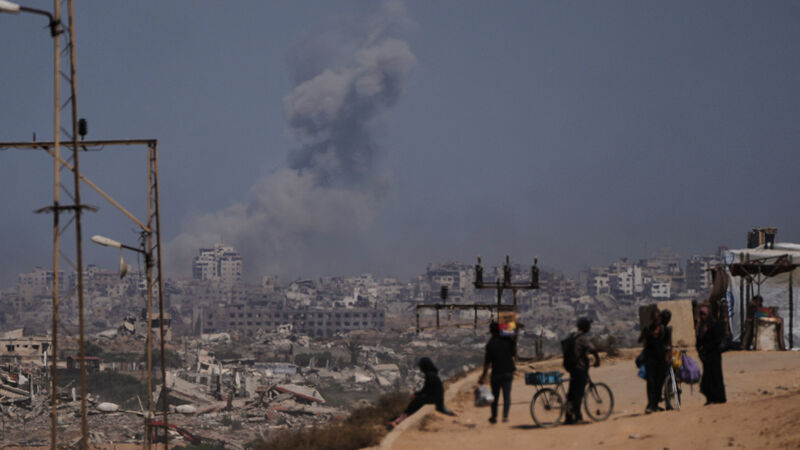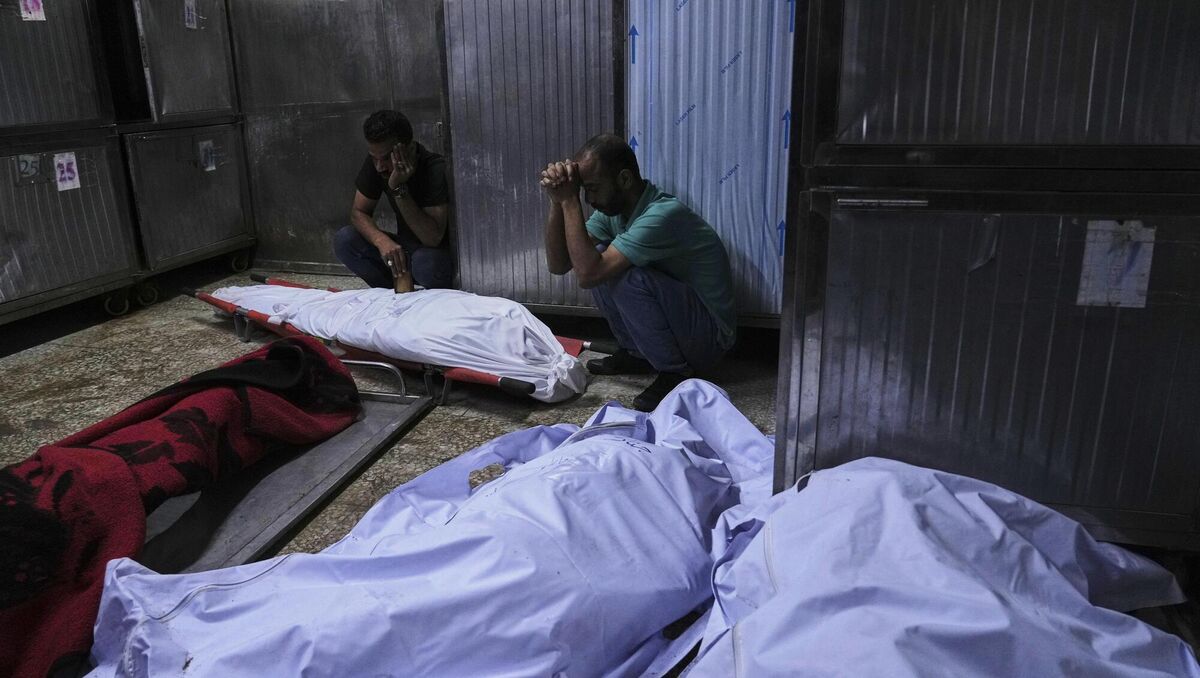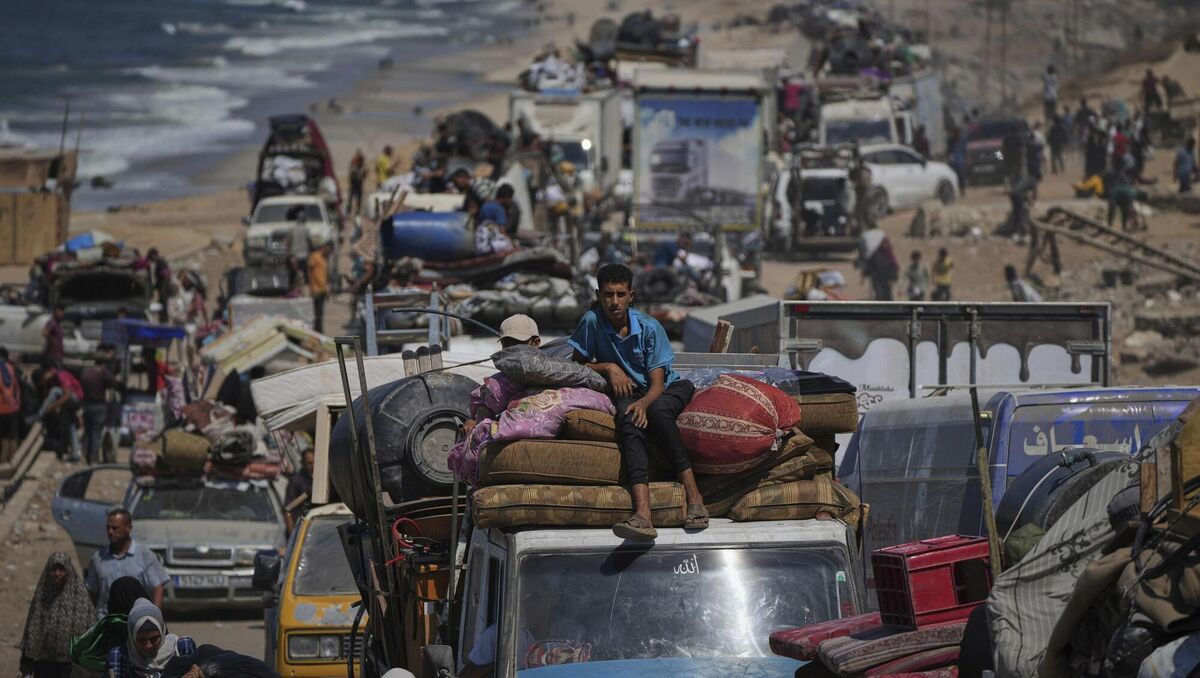UN staff refuse to flee Gaza as famine spreads and Israel blocks vital aid, Oireachtas committee hears

Smoke rises from an Israeli military strike in Gaza City, as seen from the central Gaza Strip, Monday, Sept. 22, 2025. (AP Photo/Abdel Kareem Hana)
Robot tanks are advancing on Gaza City, destroying homes in their path, but UN staff have chosen to remain and risk death alongside neighbours rather than flee again.
Because nowhere in Gaza is safe, John Whyte, acting senior deputy director in Gaza with the United Nations Relief and Works Agency for Palestine Refugees in the Near East (UNRWA), told the Oireachtas Joint Committee on Foreign Affairs and Trade today.
“Many staff have decided to stay with neighbours and die where they are [despite Israeli evacuation orders on Gaza City], because nowhere is safe.”
So far, 300 UNRWA staff and 60 workers have been killed in the war.
Some staff who went to get food from the highly dangerous Gaza Humanitarian Fund (GHF) distribution sites never returned.
“We don’t know what happened to them,” Mr Whyte said.
People going to GHF “killing zones” must be “very desperate,” risking their lives for food parcels because the sites are staffed by mercenaries licensed to shoot,” he added.
UNRWA delivered food aid in Gaza for more than 70 years without fatalities, but Israel is now blocking its work.
With the south completely overcrowded, people fleeing Gaza City have nowhere left to find shelter, Mr Whyte said.
“Imagine an area the size of Louth with 2.2m people — now 2.1m people due to those who have been killed or left — now squeezed into an area 18% that size.”
Many families have been displaced 15 to 20 times, carrying fewer supplies with each move as famine deepens and Israeli attacks destroy more areas.
Many internally displaced Gazans now sleep in the open air, with no shelter at all and winter coming in when conditions will deteriorate further, he said.

On 15 September, the Israeli military launched a “large-scale ground operation” across Gaza City, escalating attacks on residential buildings and dropping leaflets ordering residents to move south.
"Residential tower blocks and other buildings are being destroyed through aerial bombardment, artillery and the use of robotic tanks."
According to the UN Office for the Coordination of Humanitarian Affairs (OCHA), more than 20 robotic explosions were reported on 16 September alone.
The war has become increasingly mechanised, often fought remotely with drones, robot tanks and artificial intelligence.
But Gaza has long been a testing ground for the weapons industry, Mr Whyte said.
The war is being conducted more aggressively than ever, and the parties to the conflict continue with impunity, he said.
"As of 19th September, it is estimated that approximately 200,000 of the 900,000 residents in Gaza [city] have moved to the south in search of safety, many fleeing with only the most basic belongings. More are expected to do so over the coming days as the IDF ground forces closing in from the north-west and the south-east of Gaza city, however it is anticipated that many will stay, if for no other reason that they cannot afford to do so or have nowhere safe to go."
UNRWA faces a funding shortfall of €150m to reach the end of the year, Mr Whyte said.

Meanwhile, a year’s supply of flour for Gaza sits blocked in warehouses in Turkey, Egypt and Jordan, while refrigerated trucks full of insulin wait at sealed borders.
During the ceasefire, 4,200 trucks entered Gaza in a week. Before the war, 700 trucks arrived daily—500 commercial, 200 humanitarian.
Now, on a typical day, less than 50 or 60 get in, he said.
“As you are no doubt all well aware, the situation in Gaza has been dramatically deteriorating since the imposition by Israel of a blockade on the entry of supplies into the Strip at the beginning of March this year,” Mr Whyte said.
“With the absence of food supplies since that time, conditions of famine have spread across the enclave, as formally confirmed by the International Phase Classification (IPC) on the 27 August. In spite of the reopening of the border by the Israeli authorities to allow supplies to enter, the amounts that have managed to get in have been insufficient.
“As a result, conditions have not improved and a further update by the IPC later this month is expected to confirm the spread of famine to other parts of Gaza."
UNRWA provides hope in Gaza, Mr Whyte said, and Israel wants to remove that hope.












